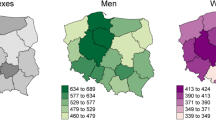We compared the descriptive epidemiology of several urinary tract cancers, utilizing incidence data from the United States and international sources. The patterns of cancers of the renal pelvis, ureter, and urethra were more similar to those of bladder cancer than to cancer of the renal patenchyma in several ways: (i) transitional cell carcinoma is the predominant histologic type in the renal pelvis, ureter, urethra, and bladder, whereas the vast majority of renal parenchyma neoplasms are adenocarcinomas; (ii) in situ tumors often appear in all these sites except the renal parenchyma; (iii) rate ratios for renal pelvis/ureter cancers among blacks and Hispanics, relative to whites, are closet to those for bladder than to those for renal parenchymal cancers; (iv) rates among US men and women for cancers of the renal pelvis and ureter are more highly correlated with those for bladder cancer than with those of the renal parenchyma across racial groups; and (v) similar correlations occur among women across geographic areas within the US and internationally. However, the patterns for cancers of the renal pelvis and ureter do not always resemble more closely those for bladder than renal parenchyma cancers and occasionally appear different from one another. These findings indicate the importance of distinguishing tumors based on specific primary site and cell type.
Similar content being viewed by others
References
American Cancer Society. Cancer Facts and Figures — 1989. Atlanta: American Cancer Society, 1989.
Devesa SS, Silverman DT, Young JLJr, et al. Cancer incidence and mortality trends among whites in the United States, 1947–84. JNCI 1987; 79: 701–70.
Arey LB. Human Histology, 3rd edn. Philadelphia: WB Saunders, 1968.
Morrison AS and Cole P. Urinary tract. In: Schottenfeld D, Fraumeni JFJr, eds. Cancer Epidemiology and Prevention. Philadelphia: WB Saunders, 1982: 925–37.
McLaughlin JK and Schuman LM. Epidemiology of renal cell carcinoma. In: Lilienfeld AM, ed. Reviews in Cancer Epidemiology, Vol 2. New York: Elsevier, 1983: 170–210.
Young JL Jr, Percy CL, Asire AJ, eds. Surveillance, Epidemiology, End Results: Incidence and Mortality Data, 1973–77. Natl Cancer Inst Monogr, 1981; 57: 1–1082.
Cutler SJ, Young JL Jr, eds. Third National Cancer Survey: Incidence Data. Narl Cancer Inst Monogr, 1975; 41: 1–454.
Heston JF, Kelly JB, Meigs JW, Flannery JT. Forty-five Years of Cancer Incidence in Connecticut: 1935–79. Natl Cancer Inst Monogr, 1986; 70: 1–706.
Percy CL, Berg JW, Thomas LB, eds. Manual of Tumor Nomenclature and Coding, 1968 edn. New York: American Cancer Society, 1968.
World Health Organization. International Classification of Diseases for Oncology. Geneva: WHO, 1976.
Muir C, Waterhouse J, Mack T, Powell J, Whelan S, eds. Cancer Incidence in Five Continents, Volume V. Lyon: International Agency for Research on Cancer, 1987; IARC Scientific Publication No. 88.
McKay FW, Hanson MR, Miller RW. Cancer Mortality in the United States: 1950–1977. Natl Cancer Inst Monogr, 1982; 59: 1–475.
Snedecor GW and Cochran WG. Statistical Methods, 6th edn. Ames, Iowa: Iowa State University Press, 1972.
International Agency for Research on Cancer. Tobacco Smoking, Lyon: IARC Monogr Eval Carcinog Risk, 1986: 38: 244–70.
Hartge P, Silverman D, Hoover R, et al. Chaning cigarette habits and bladder cancer risk: A case-control study. JNCI 1987; 78: 1119–25.
Jensen OM, Knudsen JB, McLaughlin JK, Sorensen BL, The Copenhagen case-control study of renal pelvis and ureter cancer: Role of smoking and occupational exposures. Int J Cancer 1988; 41: 557–61.
McLaughlin JK, Blot WJ, Mandel JS, Schuman LM, Mchl ES, Fraumeni JFJr. Etiology of cancer of the renal pelvis. JNCI 1983; 71: 287–91.
McLaughlin JK, Mandel JS, Blot WJ, Schuman LM, Mehl ES, Fraumeni JFJr. A population-based case-control study of renal cell carcinoma. JNCI 1984; 71: 275–84.
Piper JM, Tonascia J, Matanoski GM. Heavy phenacetin use and bladder cancer in women aged 20 to 49 years. N Engl J Med 1985; 313: 292–5.
Maclure M, MacMahon B. Phenacetin and cancer of the urinary tract (letter). N Engl J Med 1985; 313: 1479.
McCredie M, Ford JM, Stewart JH. Risk factors for cancer of the renal parenchyma. Int J Cancer 1988; 42: 13–6.
International Agency for Research on Cancer. Overall Evaluations of Carcinogenicity: An Updating of IARC Monographs Volumes 1 to 42. Lyon: IARC Monogr Eval Carcinog Risk, Supplement 7, 1987.
Silverman DT, Levin LI, Hoover RN, Hartge P. Occupational risks of bladder cancer in the United States: I. White men. JNCI 1989; 81: 1472–80.
Schmauz R and Cole P. Epidemiology of cancer of the renal pelvis and ureter. JNCI 1974; 52: 1431–4.
McLaughlin JK, Blot WJ, Mehl ES, Stewart PA, Venable FS, Fraumeni JFJr. Petroleum-related employment and renal cell cancer. J Occup Med 1985; 27: 672–4.
Maclure M. Asbestos and renal adenocarcinoma: a case-control study. Environ Res 1987; 42: 353–61.
Yu MC, Mack TM, Hanisch R, Cicioni C, Henderson BE. Cigarette smoking, obesity, diuretic use, and coffee consumption as risk factors for renal cell carcinoma. JNCI 1986; 77: 351–6.
McLaughlin JK, Blot WJ, Fraumeni JFJr. Diuretics and renal cell cancer (letter). JNCI 1988; 80: 378.
Kantor AF, Hartge P, Hoover RN, Narayana AS, Sullivan JW, Fraumeni JFJr. Urinary tract infection and risk of bladder cancer. Am J Epidemiol 1984; 119: 510–5.
Cantor KP, Hoover R, Hartge P, et al. Bladder cancer, drinking water source, and tap water consumption: A case-control study. JNCI 1987; 79: 1269–79.
Additional information
Drs Devesa, Silverman, McLaughlin, and Fraumeni are in the Epidemiology and Biostatisties Program, Division of Cancer Etiology, and Dr Brown and Mr Connelly are in the Biometry Branch, Division of Cancer Prevention and Control-both Divisions of the US National Cancer Institute, Bethesda MD, USA. Address reprint requests to Dr Devesa at Executive Plaza North-Room 415, Bethesda MD, USA 20892.
Rights and permissions
About this article
Cite this article
Devesa, S.S., Silverman, D.T., McLaughlin, J.K. et al. Comparison of the descriptive epidemiology of urinary tract cancers. Cancer Causes Control 1, 133–141 (1990). https://doi.org/10.1007/BF00053164
Received:
Accepted:
Issue Date:
DOI: https://doi.org/10.1007/BF00053164




